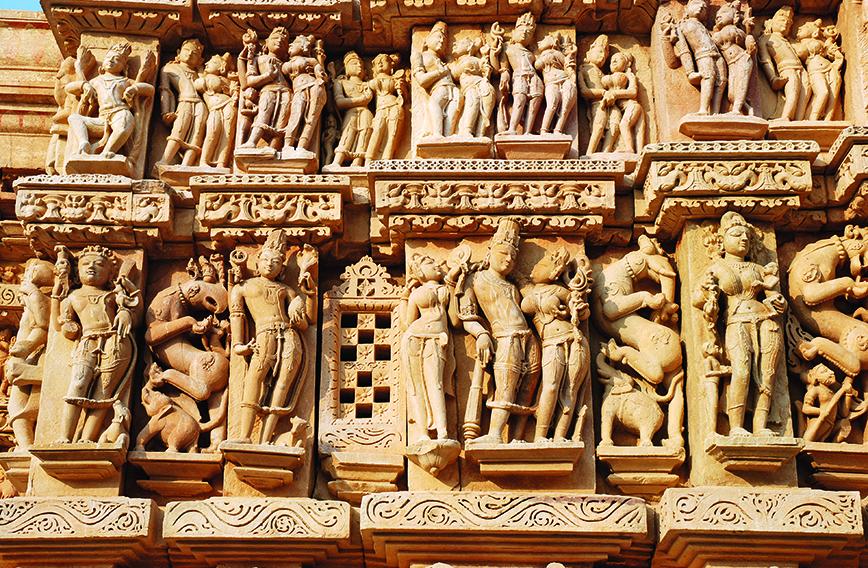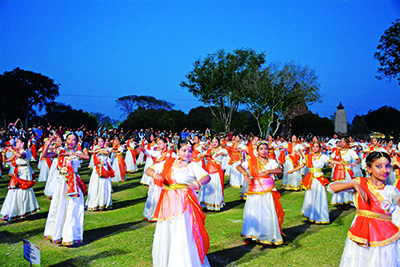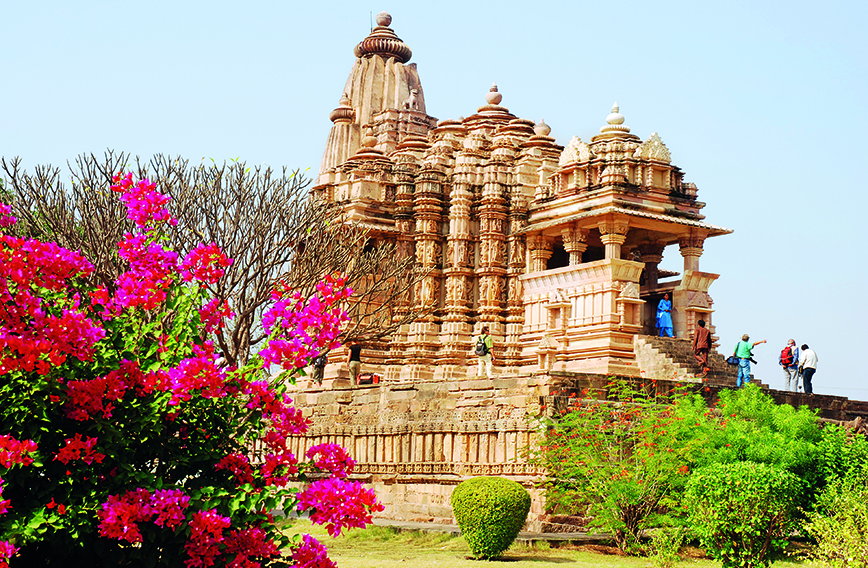
The walls of temples in Khajuraho are famous for their intricate carvings | Civil Society pictures/Susheela Nair
Khajuraho: Check out love and life in the temple city
Susheela Nair, Khajuraho
AS we passed tree-lined avenues and green-dotted rocky outcrops on our way to the venue of the 50th edition of the Khajuraho Dance Festival, little did we know what awaited us. A magnificent Kathak Kumbh with 1,484 kathak dancers swaying to the rhythm of Raja Basant — a performance that entered the Guinness Book of World Records.
We were at the offbeat locale of the UNESCO World Heritage Site of Khajuraho, a historical town in Madhya Pradesh. Built within an amazingly short span of 100 years, between the ninth and 11th centuries, by the rulers of the Chandela dynasty, only 22 of the original 85 temples have survived the ravages of time.
We discovered a bewildering wealth of detail in the ornate carvings in these temples. On every inch of these temples there are carved figurines posing, dancing, indulging in daily activities like admiring themselves in mirrors, combing their hair, gossiping and making love. But it is definitely the unusual poses immortalising the ecstasy of passion and the fervent beauty of love that have made Khajuraho’s temples unique and famous!
Within this Indo-Aryan architectural brilliance, gods and goddesses, warriors and musicians encapsulate history and mythology. But the highlight is the theme of women and erotica engraved on sandstone, a celebration of women and a myriad of moods and facets.
The temples mark the culmination of the Central Indian style of architecture. Here the Nagara style of architecture is discernible in all its glory. The temples are compact and lofty, sans an enclosure wall, and are erected on a high platform-terrace which elevates the structure from its environs, and provides an open promenade, around which one can walk. We found an amazing exuberance of decorative details and sculptural wealth, largely on doorways, pillars, and ceilings. These sculptures embody the nuances of intellectual and sensual rapture.
The temples are spread out amongst three geographical groups — the Western, Eastern and Southern. In the Western group the temples are laid out in two rows. The Lakshmana temple, the Matangeswara and the Varaha form one complex, with the Vishwanatha and Nandi temples a little farther off, while the Chitragupta, Devi Jagadamba and Kandariya-Mahadeva temples form the other.
 |
|
Kathak dancers perform to the rhythm of Raja Basant |
Ambling around the temple complex in the fenced-in parkland of the Western group, we found the temples towering over well-kept lawns, brightened by vivid patches of bougainvillea. We began our heritage sojourn with the Lakshmana Temple, the oldest and best preserved of the group of temples. The intact platform, with friezes of apsaras, erotic scenes, ceremonial processions, martial scenes, cameos of the daily rhythm of life, scenes of domestic bliss and a moving pageant of hunting and battle scenes take one’s breath away. The Lakshmana Temple sports the stylised arch called makaratorana, which is the most appealing of all the sculptural decorations.
Facing the large Lakshmana Temple is a small shrine of Varaha, a reincarnation of Vishnu. The sandstone image of Varaha, 1.5 metres high and intricately carved with figures from the Hindu pantheon, and the ceiling embellished with an exquisitely designed lotus flower in relief left us spellbound. A pedestal under the boar depicts the serpent, Sheshnaga, in a devotional posture and also the feet of the broken figure of the earth goddess. The Matangeswara Temple, adjacent to Lakshmana, outside the fenced enclosure, is the one most frequented by the local populace. The object of veneration here is the enormous 2.5-metre lingam installed in the sanctum.
Just a hop away is the Vishwanath Temple, similar to the five-part design structure of the larger Kandariya-Mahadeva Temple. The steps leading to the temple on the northern side are flanked by lions and on the southern side by elephants. We saw a profusion of carvings on the exteriors — from traditional images of women writing letters, fondling babies, and playing music to well-endowed women depicted in the most sensuous postures. There is an impressive three-headed image of Brahma enshrined in this temple. Also remarkable is the large image of Shiva’s vehicle, Nandi the bull, overlooking the temple on a square pavilion from the other end of the common platform.
From there, we moved to Kandariya-Mahadeva. Spearing the sky is a grand 31-metre-high shikhara decorated with an ascending series of 84 subsidiary spires, a highly imaginative recreation of the rising peaks of the Himalayas, the abode of the gods. We lost track of time at this temple, admiring the lavishly carved 872 statues, most of them a metre tall. It is the most splendid of the temples in Khajuraho, with depictions of alluring women, musicians playing different instruments, lovers in fond embrace, huge crocodiles, winged gods, goddesses and sensual ecstasy at its height. The excellently executed entrance arch, ceilings and pillars are unforgettable.
Mahadeva is a small, largely ruined, temple standing on the same platform as the Kandariya-Mahadeva and Devi Jagadamba. Although small and insignificant compared with the mighty neighbours, it houses one of Khajuraho’s finest sculptures — a sardula figure caressing a lion. Devi Jagadamba, one of the most erotic temples in Khajuraho, houses the famed mithuna images, and sensuously carved figures.
 Chitragupta, a temple dedicated to Lord Surya
Chitragupta, a temple dedicated to Lord Surya
At Chitragupta Temple, the fourth temple at the back of the enclosure, is an imposing deity of Surya, the sun god, riding his chariot with its seven horses, while on the central niche in the south façade is an 11-headed statue of Vishnu. It has some fine sculptures portraying royal processions, elephant fights, hunting scenes and group dances, reflecting the lavish lifestyle of the Chandela kings and their courts. The Chaunsath Yogini temple, the only granite temple in the complex, is dedicated to Kali.
We were unable to see the Eastern group, largely devoted to three Jain temples, and the Southern group comprising the Duladeo and Chaturbhuja temples as it became time to go to the Dance Festival.
Comments
Currently there are no Comments. Be first to write a comment!



